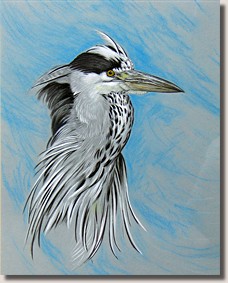 | |||||||||||
 | |||||||||||
 | Common Moorhen, Gallinula chloropus, night calls I don't normally set out to record Moorhens -- they're just around, one hears them quite often and everyone knows what they sound like . . . don't they. Well, one night in April 2005 I was sitting out recording a Nightingale when this happened: Nightingale interrupted (400.52 K) Weird! It stopped the Nightingale singing for a minute or so, after which he restarted as if nothing had happened and continued for hour after hour. I was left imagining some phantasmagoric night bird of prey, unknown to ornithology, that had attempted to take the little Nightingale from his perch. In fact I should have known better as a couple of hours earlier, around midnight, I'd recorded these two birds near a style some 200 yards away. This clip contains some much more moorhenny-type sounds. Moorhen pair from style (936.75 K) But Moorhens flying around at night?! For two years I wondered and the birds remaind unidentified. I often heard them during that period, usually when I spent nights out recording at our Tawny Owl nestbox, but also from a quiet lane some way away across fields. I heard them most recently this May (2007). Oddly I have never heard them during the day. It's not an area one would immediately associate with Moorhens, or other "water" birds, as the edge of the wood where they roost is on a low ridge and relatively waterless. Moreover they're sharing territory with a couple of Tawny Owls! As they're active at night they must frequently encounter the owls. Eventually I decided to settle the problem by putting up a query on two forums: Nature Recordists and Bird Forum. The replies were very definite: Moorhen. But the enquiry brought some interesting observations from a Dutch respondent, which is why I've included these recordings here. Apparently the night calls made by Coots, Moorhens and other rails have had Dutch birders equally mystified, even resulting in the suggestion that the Coot's night-time calls were made by Long-eared Owls! For anyone interested in the discussion, here's the answer as kindly explained by the Dutch respondent in Nature Recordists message 29306. His webpage ("Coot or Long-eared Owl") he refers to is here -- don't use the link in the thread as it includes a full stop and doesn't work. This is a very interesting page and goes over exactly the same ground for Coots, as well as including sound clips of the equivalent Coot night calls. Finally, for anyone wanting to plough through the discussion on Bird Forum, which contains a little more on the Moorhen topic, it's here: Unknown night bird, Kent, England. There's a daytime recording of a Moorhen on the Mixed birds page. Enough of Moorhens for the time being. But if ever you want a bird identified, try the Bird Forum identification Q&A. You can get an answer within 5 minutes! Fantastic. | ||||||||||
Grey Heron, Ardea Cinerea Many nights when I was out under the Tawny Owls nestbox in spring 2006 I'd hear the heavy whooshing of overflying Greay Herons. Then, soon after dawn one morning (11 May) one flew over squawking all the way. I'm afraid I was so surprised I've rather spoilt the recording: Grey Heron in flight (655.52 K) (128 kb/s) Some nights it seemed one went over every hour. I have no idea where they were going as I was always wearing headphones. In one recording made by equipment left out overnight under tall trees in 2004 there's a tremendous crash as something collides with branches high above. I've always assumed it was one of these herons. Oddly, considering the number of these overflying birds, we've never found any on the ground in our area. Left: Striking portrait of a Grey Heron by Scottish wildlife artist Dennis McCallum. Done in watercolour and gouache. The heron is on the Birds page of this new site, along with, among others, a rather nice Tawny Owl. | |||||||||||
 |  | ||||||||||
powered by owls | |||||||||||